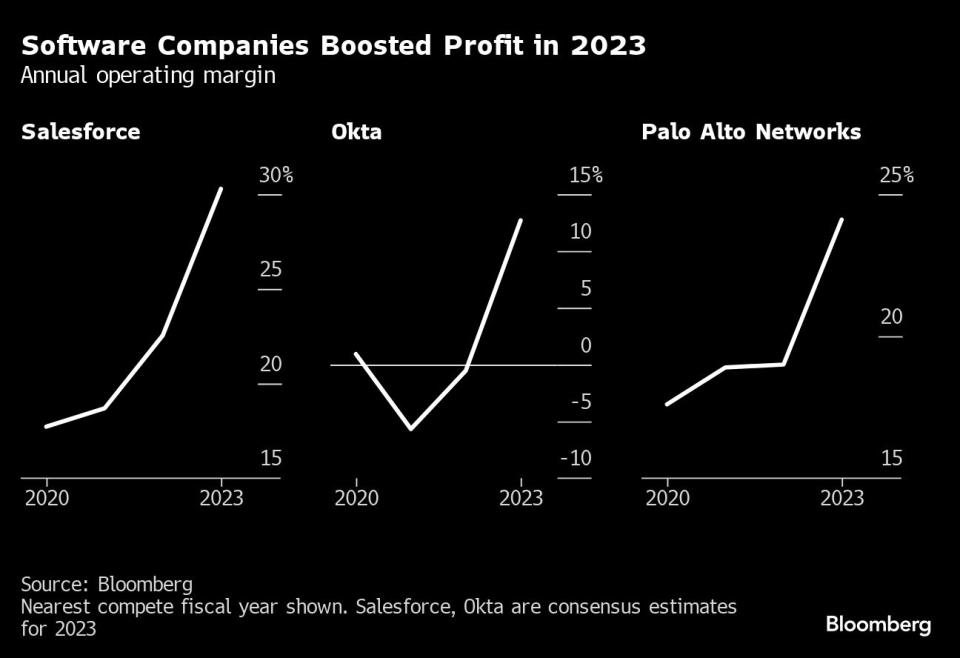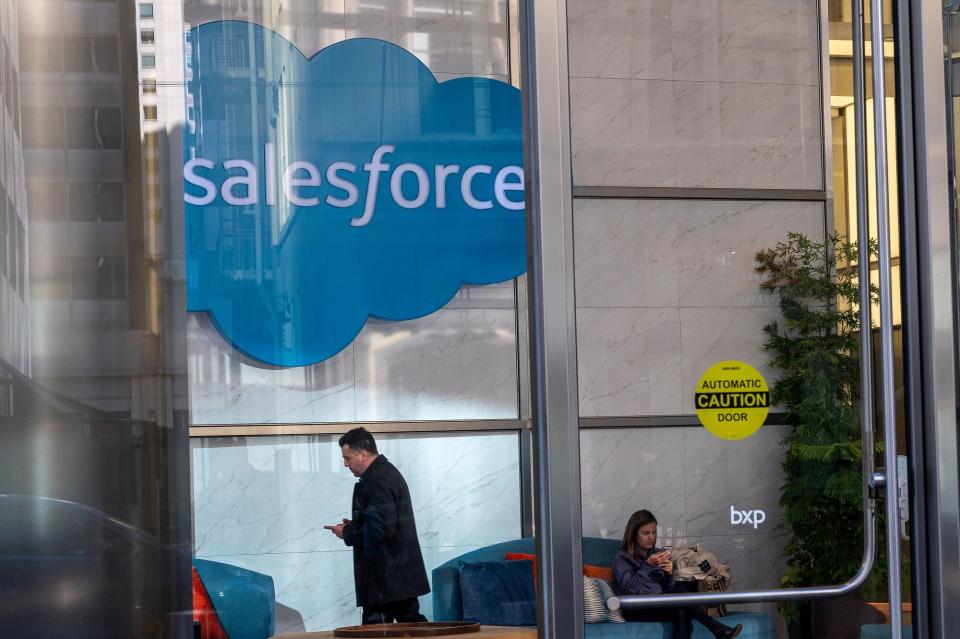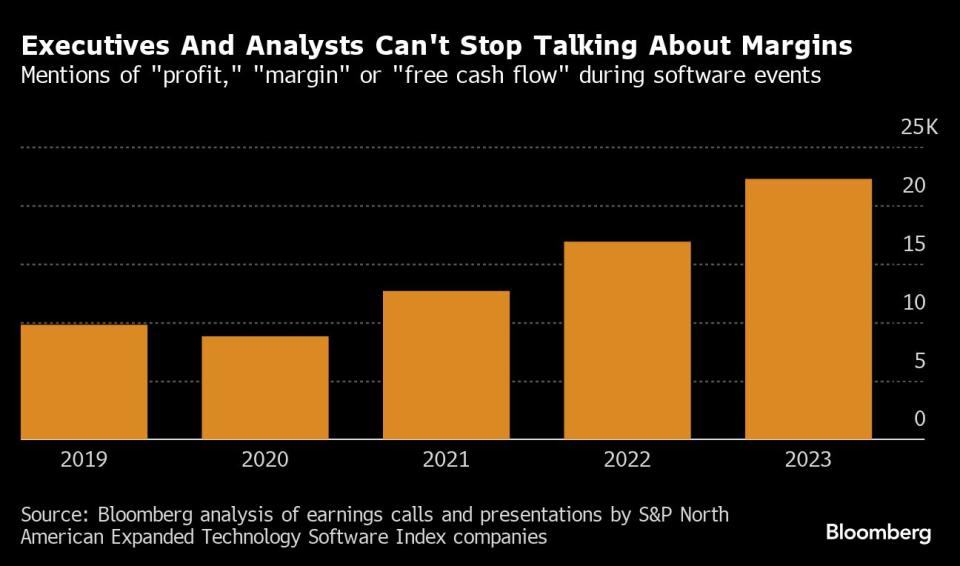Software Companies Finally Had to Care About Profit in 2023
(Bloomberg) -- For much of the last decade, software companies just focused on growing as quickly as possible. That changed in 2023. Profit and operating margin became the industry’s watchwords.
Most Read from Bloomberg
Just a Billion Doesn’t Cut It on This Exclusive Florida Island
Confidential Jeffrey Epstein Documents Unsealed by New York Court
Tech’s Losing Streak Extends Ahead of Jobs Test: Markets Wrap
Deadly Iran Blasts and Red Sea Warnings Fan Mideast Tensions
As interest rates climbed and corporate technology budgets got cut, hawking computer applications began to look less like an endless well of expansion. Investors grew tired of the growth-at-all-costs mindset that had dominated the software industry since the great financial crisis.
Management teams responded by firing workers, offshoring labor, paring back benefits, closing offices, ending speculative projects and scrutinizing their own software budgets. Broadly, they tried to replace cultures of abundance with ones of frugality.
Software executives and Wall Street analysts talked about profit more than twice as often in 2023 as they did in 2019, according to an analysis of transcripts of earnings calls, corporate events and other presentations compiled by Bloomberg. By comparison, references to “growth” and “revenue” grew less than half as quickly across that period.
“The new fashion right now is to talk about operating margin,” said Varonis Systems Inc. Chief Financial Officer Guy Melamed during a May earnings call.
Pressure was acute for money-losing companies. Twilio Inc., which makes communication software, conducted three rounds of layoffs and clipped perks such as sabbaticals and book allowances. The company is expected to post its first significant adjusted profit per share this year.
Snowflake Inc., Okta Inc., and Nutanix Inc. are other companies that posted or will post their first major annual profit in 2023. Box Inc. saw its first positive operating margin.
The most dramatic change in emphasis was by Salesforce Inc., which is often seen as a bellwether for the industry. Facing slowing sales growth, a cadre of activist investors called for the company — then valued at about $150 billion — to stop burning cash like a startup and boost margins to the standards of Adobe Inc. and Oracle Corp.
Read More: Era of $800 Dinners and Luxury-Car Bonuses Is Over at Salesforce
Many figured highly visible marketing like its Dreamforce conference in San Francisco were the source of Salesforce’s overspending. In reality, the biggest issue was compensation for its massive team of salespeople. Beyond its largest-ever job cuts, Salesforce has worked to bundle its products and sell them through new channels like Amazon.com Inc.’s cloud unit, Amazon Web Services, and self-service sites in order to spend less on commissions.
Workday Inc. and HubSpot Inc., also spoke about trimming sales-and-marketing costs. That expense line is often the largest for enterprise tech companies, which rely on armies of sales representatives to explain why their wonky products are needed.
On the engineering side, many companies hired research-and-development talent overseas for lower salaries. ServiceNow Inc., Appian Corp., PTC Inc. and LiveRamp Holdings Inc. each spoke about cost-savings from adding developers in India. C3.ai Inc. talked up higher margins from a new research center in Guadalajara, Mexico, while Box mentioned hiring more engineers in Poland.
The changes led to an increase in margins for many companies that had largely ignored the metric. iShares’ software ETF, a common industry benchmark, is up about 60% this year due largely to greater profit and excitement around generative artificial intelligence, said Rishi Jaluria, an analyst at RBC Capital Markets.
Moving forward, the question is whether some companies have put off investing enough in new growth drivers during their campaigns to boost margins, which could hurt future expansion, Jaluria added.
Microsoft Corp. and Adobe, mature companies that already have industry-high profitability, said they were spending heavily in new artificial intelligence capabilities — and managed to avoid denting their margins. Microsoft poured $13 billion into ChatGPT maker OpenAI. Speculative bets were cut in the name of big growth drivers — Adobe put its Figma Inc. competitor XD on life support while Microsoft scaled back teams behind hardware devices like augmented reality goggles.
“We’re really focused on making sure that every dollar we commit is back to the priorities we talked about, which is commercial cloud leadership and leading the AI wave,” Microsoft Chief Financial Officer Amy Hood said during an October earnings call.
A notable exception to the trend was Oracle, which saw its margins dip as it built out its cloud infrastructure offering and integrated acquired electronic health records firm Cerner. Chief Executive Officer Safra Catz is working to shift the legacy software business to the cloud, and drive profitability to “Oracle standards.”
Tech industry struggles this year fell particularly hard on startups — the newer and often unprofitable companies that could grow to be enterprise giants of the future. An unprecedented number went belly-up in 2023, in part due to difficulty in raising money, according to data from equity management company Carta Inc.
Some sold themselves at fire-sale prices. Videoconferencing upstart Loom had two rounds of job cuts, then was sold in October to Atlassian Corp. for $975 million — significantly less than its previous $1.53 billion valuation.
Read More: 2023 Was Bad for Startups With Bankruptcies, Lower Valuations
Looking into the new year, many on Wall Street expect corporate tech spending to rebound as interest rates ease and demand continues to grow for artificial intelligence. This year’s profit orientation has changed the mindset of many leadership teams, but it’s possible the pendulum could swing back, RBC’s Jaluria said. “Two years from now, we could be entering growth-at-all-costs again.”
--With assistance from Sarah McBride.
Most Read from Bloomberg Businessweek
©2024 Bloomberg L.P.



